Click on images to enlarge

infestation in a waterway (Photo: Sheldon Navie)
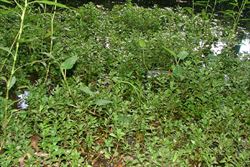
infestation on muddy soil (Photo: Sheldon Navie)
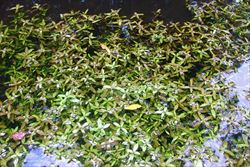
submerged habit (Photo: Sheldon Navie)
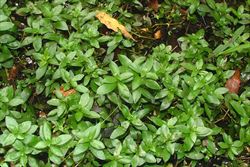
terrestrial habit (Photo: Sheldon Navie)

stems with roots at their joints (Photo: Sheldon Navie)
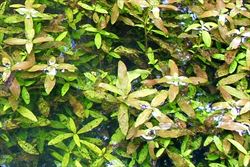
submerged leaves (Photo: Sheldon Navie)
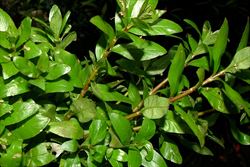
emergent leaves (Photo: Sheldon Navie)

close-up of younger emergent leaves (Photo: Sheldon Navie)
Scientific Name
Hygrophila polysperma (Roxb.) T. Anderson
Synonyms
Justicia polysperma Roxb.
Family
Acanthaceae
Common Names
dwarf hygrophila, East Indian hygro, East Indian hygrophila, East Indian swampweed, green hygro, hygro, hygrophila, Indian swamp weed, Indian swampweed, Indian water star, Miramar weed, oriental ludwigia
Origin
Native to the Indian Sub-continent (i.e. Bangladesh, Bhutan, India and Nepal) and south-eastern Asia (i.e. Cambodia, Laos, Myanmar, Thailand and Vietnam).
Naturalised Distribution
Currently only naturalised at a few locations in south-eastern Queensland and north-eastern New South Wales.
Also naturalised overseas in eastern USA (i.e. Florida, Texas and Virginia).
Notes
East Indian hygrophila (Hygrophila polysperma) is regarded as an emerging environmental weed in Queensland and New South Wales. This species was first collected in Australia in August 2005 in the Caboolture River north of Brisbane. It was growing along the riverbank and in the water, both as a submerged aquatic and terrestrial plant. East Indian hygrophila (Hygrophila polysperma) is thought to have escaped cultivation as an aquarium plant and has since been found along the Tweed River and Clarence River in coastal northern New South Wales and along Enoggera Creek in suburban Brisbane.
This species has the potential to become a serious weed of freshwater lakes, ponds and dams in eastern Australia. It prefers flowing water in warmer environments, but may also be found in slow moving waters and lakes. East Indian hygrophila (Hygrophila polysperma) is fast growing invasive plant that out-competes native aquatic plants. It can occupy the entire water column and also creates problems as an emergent plant along the margins of waterbodies.
East Indian hygrophila (Hygrophila polysperma) has replaced hydrilla (Hydrilla verticillata) as the major aquatic weed in some parts of Florida, and is considered by the state's Exotic Pest Plant Council to be one of the most invasive non-indigenous aquatic plants in this part of the USA. It forms dense stands and floating mats of vegetation in waterways, canals and drainage ditches, which obstruct water flow and displace native vegetation. Its ability to form a dense canopy at the water-air interface is of particular concern, because this enables it to shade out all other submerged plants.

